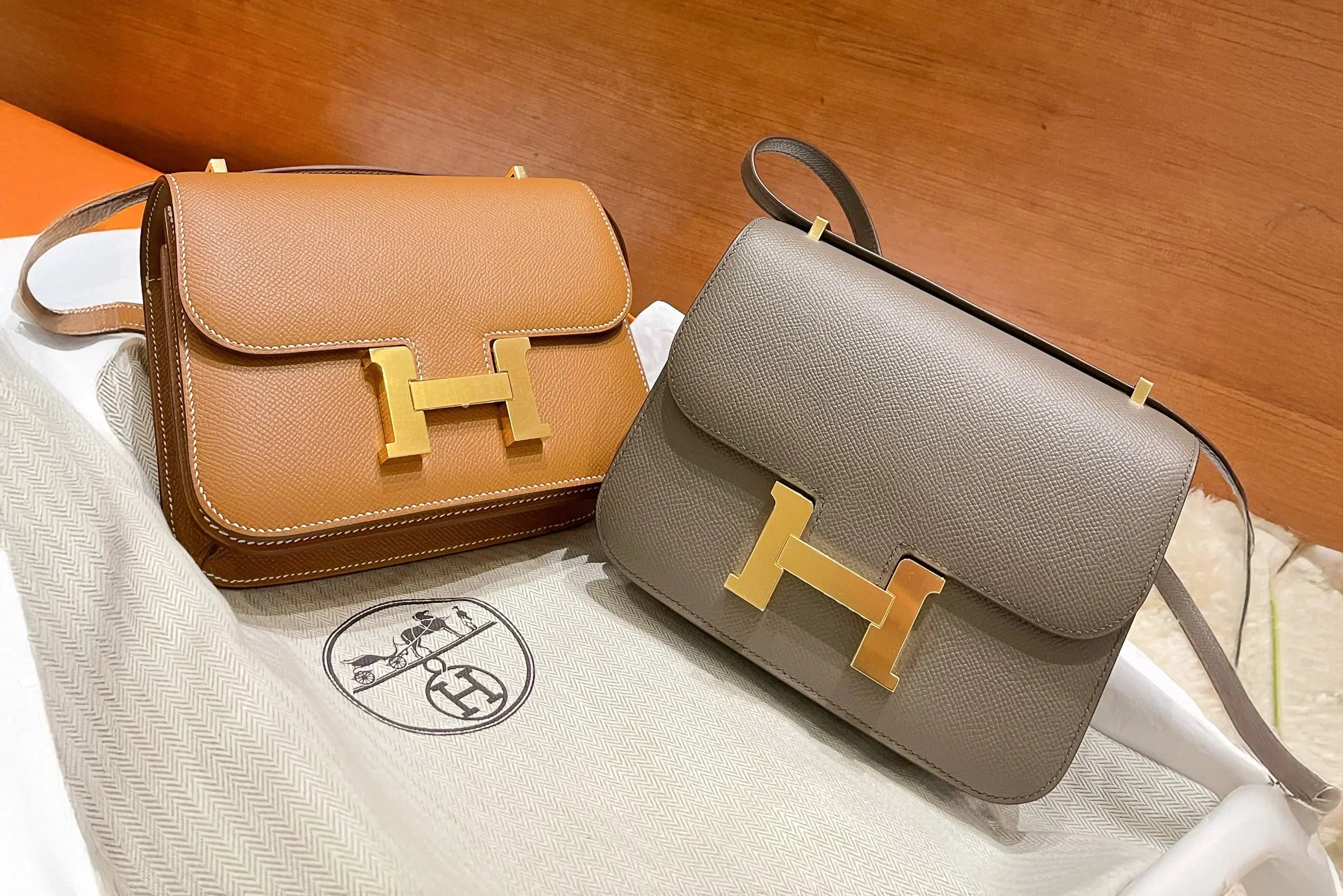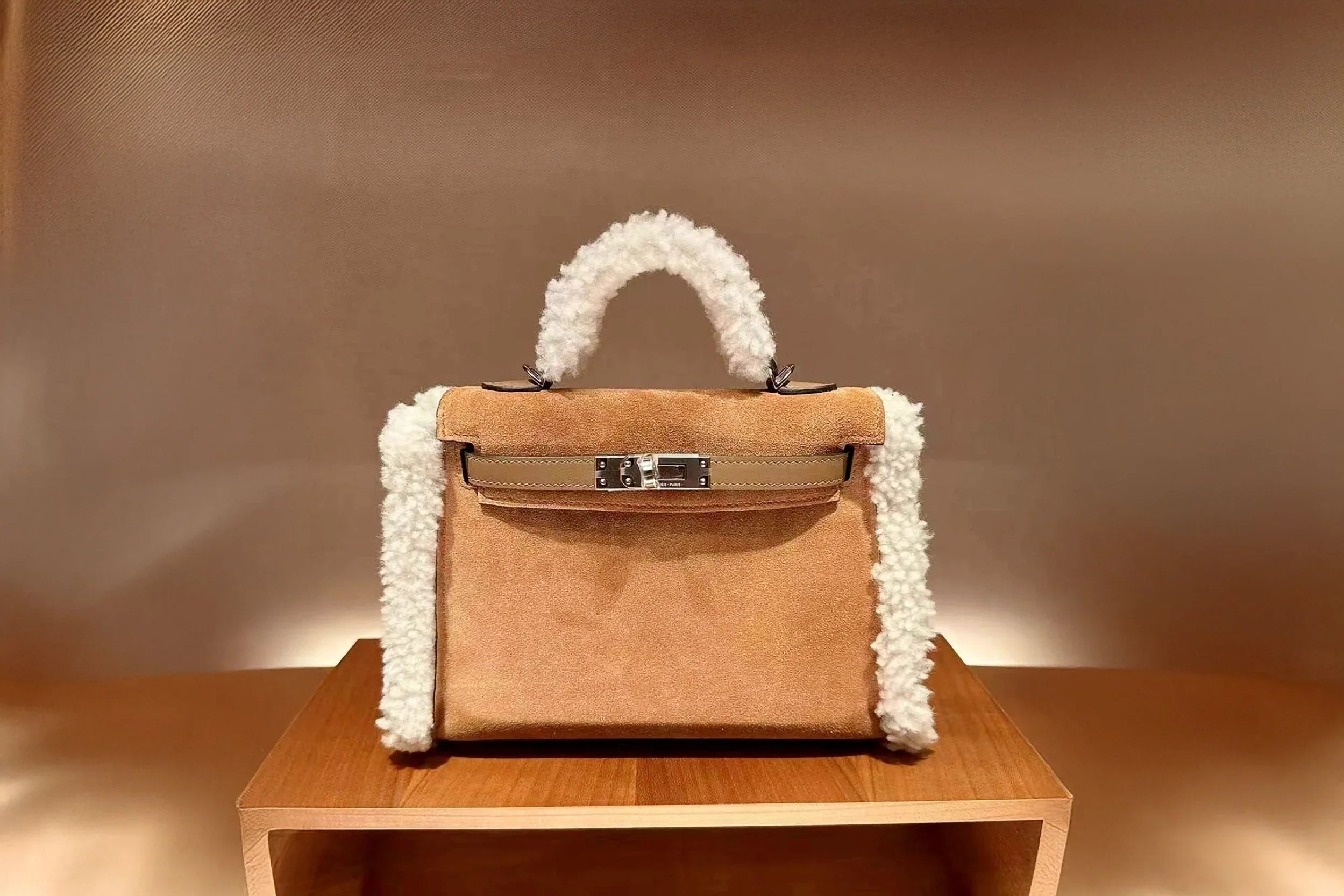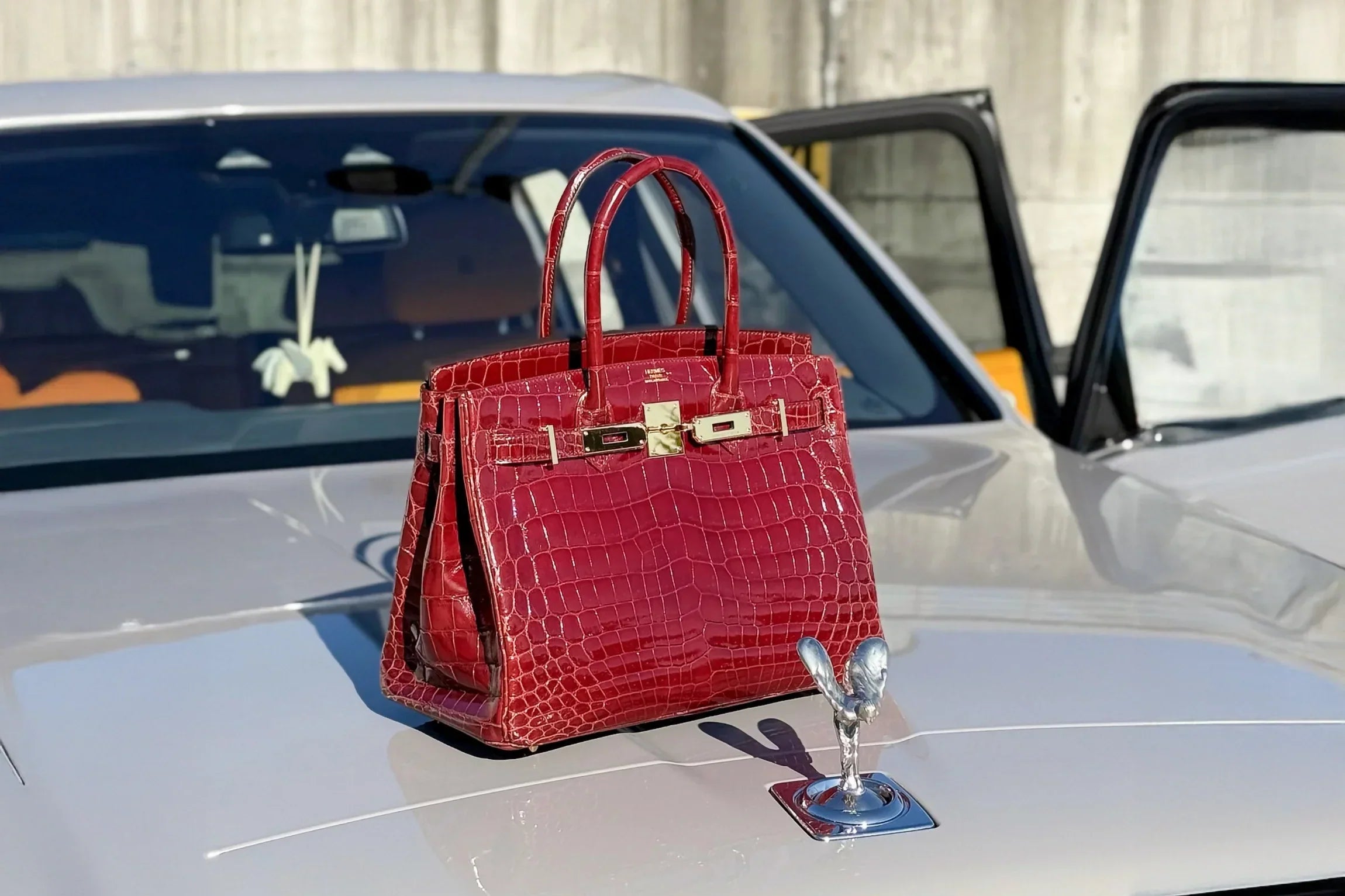
Long-Term Hermès Bag Storage Solutions for Collectors
Check out our Hermès collection and Birkin bags!
Hermès bags are not just luxury accessories, they are investments that can appreciate if you treat them right. For collectors, knowing how to store these beauties long-term is crucial for keeping their condition and value intact.
Proper storage means removing plastic seals, controlling humidity, stuffing with care, and keeping bags away from sunlight and heat.
We have all heard those horror stories: someone finds their Birkin or Kelly after years tucked away, only to discover cracked leather, faded color, or deep creases. It is a collector’s nightmare, but it is preventable with a little know-how.
Whether you are rotating your collection or tucking away an investment piece, what you do now will decide how your bag looks years down the road.
From why you need to remove those plastic seals to the debate between dust bags and storage boxes, let us dig into how to keep your Hermès bags gorgeous and valuable for the long haul.
Key Takeaways
- Remove plastic seals and prep bags before storing to avoid damage
- Control humidity, temperature, and light to keep leather and color fresh
- Use the right stuffing and coverings, and keep up with regular maintenance
Why Proper Long-Term Storage Is Essential for Hermès Bags
How we store our Hermès bags affects their condition, value, and desirability on the resale market. Bad storage can wreck leather, hardware, and structure, reducing what someone might pay for your bag.
Maintaining Value and Condition
Hermès bags need careful handling to stay in top shape. Changes in temperature, humidity, and UV light can damage leather, causing cracks, fading, or loss of structure.
- A Birkin left on a shelf the wrong way can lose its shape fast. Saggy corners or creased handles are hard to fix, even with a professional.
- Different Hermès leathers react in their own ways. Swift leather is prone to water marks, while Clemence can crease if squished.
- Humidity is tough on hardware. To keep palladium or gold-plated bits shiny, aim for 40-50% humidity.
- Acid-free tissue and original dust bags are must-haves. They prevent color transfer and scratching, making a significant difference.
Impact on Resale Market
The resale market judges Hermès bags by condition, which depends on storage. Bags in pristine shape can sell for 85-95% of retail, but storage-damaged ones might only get 60-70%.
Buyers and auction houses look for telltale signs:
- Creased handles from hanging
- Oxidized hardware from humidity
- Dry, brittle leather from heat or cold
- Misshapen bags from bad stuffing
Authentication services spot poor storage immediately. Mould, odd smells, or saggy shapes are deal-breakers. A carefully stored 10-year-old Birkin can fetch more than a poorly kept 5-year-old.
Risks of Poor Storage
Poor storage can lead to costly repairs or irreparable damage. Sunlight will fade leather permanently, especially lighter shades like Craie or Rose Sakura.
Plastic bins trap moisture, leading to mould that seeps into leather and leaves an odor you cannot remove. Hanging bags stretches handles and stresses attachment points, potentially causing separation.
Common mistakes:
- Stuffing with newspaper (ink stains)
- Storing in attics or basements (bad temperatures)
- Leaving bags in plastic wrap
- Piling bags on top of each other
Any of these can reduce a bag’s value by thousands or make it unsellable.
Optimal Pre-Storage Prep: Cleaning and Conditioning
Before storing your Hermès bags, clean them to remove oils and dirt, then condition to keep the leather supple. Skipping these steps can cause long-term damage and lower your bag’s value.
How to Safely Clean Hermès Leather
Empty everything and shake out crumbs or bits from pockets. For dust, a soft, dry microfiber cloth works well.
For a deeper clean, use a barely damp cloth with distilled water, not tap water, as minerals can stain. Work in small circles and avoid soaking the leather.
Cleaning Steps:
- Test on a hidden spot first
- Use cleaners made for luxury bags
- Avoid harsh chemicals, baby wipes, or household products
- Wipe hardware with a dry cloth
For stubborn marks, contact Hermès. Their leather spa knows how to treat each bag. Some stains need professional attention.
Importance of Conditioning
Conditioner prevents leather from drying out and cracking. Apply every six months or before storing for over three months.
Choose a conditioner for luxury leather and use sparingly. Work it in gently, then let the bag absorb it for a few hours before storing.
Why condition?
- Keeps leather flexible
- Prevents cracking and stiffening
- Preserves natural oils
- Extends bag lifespan
Do not overdo it. Excess conditioner can darken leather or leave a greasy film.
Common Mistakes to Avoid
Using generic leather cleaners for furniture or cars can alter color or finish permanently. Never store a damp bag, as it invites mould and stains. Let it air dry for at least 24 hours in a cool, dry place.
Big prep mistakes:
- Using heat to speed drying
- Using petroleum-based products
- Storing right after conditioning
- Neglecting hardware cleaning
Avoid over-applying conditioner, as it attracts dirt and makes the bag sticky.
Choosing the Right Environment for Storage
Where you store your Hermès bags can make or break them. Stable temperature, controlled humidity, and light protection are essential for keeping luxury bags at their best.
Temperature and Humidity Guidelines
Maintain 15-21°C. Temperature swings cause leather to expand and contract, leading to cracks and warped shapes.
Keep humidity between 45-55%. Too damp causes mould and soft leather; too dry can crack leather.
Ideal Storage:
- Temperature: 15-21°C
- Humidity: 45-55% RH
- Air: Some circulation, not stuffy
Avoid basements or attics, as they are unpredictable. A climate-controlled closet or dedicated room is ideal. Use a hygrometer to monitor conditions, and employ small humidifiers or dehumidifiers if needed.
Sunlight and Light Exposure
Sunlight fades and weakens leather, even indirectly. Hardware finishes can also suffer.
Artificial lights like fluorescent or LED can cause slow UV damage over time. Store bags in the dark, ideally in a closet with solid doors.
For display, use UV-filtering glass and keep away from windows. Rotate displayed bags to prevent uneven fading.
Light Protection:
- No direct sunlight
- Avoid fluorescent lights
- Use UV filters for displays
- Rotate bags monthly
Safe Location: Shelves, Closets, and Safes
A dedicated closet shelf is practical, with adjustable shelves spaced 30-40cm apart to fit most bags without squishing.
Walk-in closets with climate control are ideal, ensuring air circulation to prevent mustiness. For valuable pieces, a fireproof safe with climate control is a good option, but ensure it does not compress the bag.
Never store bags on the floor, as concrete can be cold and damp. Use raised shelves or platforms.
Storage Priorities:
- Climate control
- Security
- Easy access for rotation
- Enough space for proper positioning
Custom acrylic cases are great for dust protection while displaying, ideal for collectors who admire their collection.
Stuffing and Shaping: Preserving the Silhouette
Proper stuffing maintains the Hermès bag’s shape, preventing sagging, creasing, or hardware marks. The right materials and techniques keep your investment sharp for decades.
Support Materials: Tissue, Bubble Wrap, and Alternatives
Acid-free tissue paper is ideal for Hermès stuffing. Regular tissue can stain, so invest in quality materials.
Avoid newspaper, as ink stains, especially on lighter leathers. Cotton batting suits smaller bags, holding shape without bulk. Air paper (bubble-free packing) works for structured bags like the Birkin or Kelly, as it is light and retains form.
| Material | Best For | Avoid If |
|---|---|---|
| Acid-free tissue | All Hermès bags | On a tight budget |
| Air paper | Structured bags (Birkin, Kelly) | Soft leather styles |
| Cotton batting | Small bags, tight spaces | Bag has delicate lining |
Wrap hardware in tissue before tucking inside to prevent scratches or dents.
Why Shape Retention Matters
Losing shape reduces value. A saggy Birkin can sell for 30-40% less than one with crisp lines. Leather retains storage shape, and creases or dents are often permanent.
Proper stuffing prevents:
- Handles from drooping
- Corners from rounding out
- Sides from collapsing
- Hardware from leaving marks
Temperature changes can make leather swell or shrink. Good internal support maintains form.
Special Considerations for the Birkin
The Birkin’s trapezoid shape needs extra care. Support the base firmly to keep corners defined, but avoid overstretching the leather.
Use a tissue cylinder in the center to maintain width and prevent side collapse. Add a gentle layer of tissue under the flap before closing, without forcing it. Keep handles upright to avoid drooping, a sign of poor storage.
Check stuffing every six months and adjust if it settles.
Protective Coverings: Dust Bags, Boxes, and What Not to Use
The right covering protects your Hermès collection. Original dust bags are best, plastic is a no-go, and orange boxes have specific uses.
Original Hermès Dust Bags vs. Third-Party Solutions
Hermès dust bags are designed for these bags, with breathable cotton that prevents moisture while blocking dust and scratches. They fit perfectly, and the soft lining avoids scratches.
Third-party options can cause issues:
- Generic cotton bags may not fit
- Cheap materials might bleed dye
- Some trap moisture
Poor dust bags can cause pressure marks. If you lose your dust bag, contact Hermès for possible replacements with authenticity proof.
Dangers of Plastic Covers
Never store Hermès bags in plastic, as leather needs airflow. Plastic traps humidity and oils, causing:
- Mould on leather
- Color bleeding
- Warped shapes
- Permanent stains
Even clear garment bags are risky for long-term storage.
When to Rely on the Hermès Orange Box
Orange boxes are ideal for long-term protection or moving. Use them for:
- Storing bags for months or years
- Moving or shipping
- Protecting from environmental swings
They block light, crucial for exotic leathers sensitive to UV. However, frequent access wears down the boxes, and cardboard can degrade. Store boxes in stable conditions, avoiding basements or attics to prevent condensation.
Rotation, Access, and Long-Term Maintenance
Rotating your collection keeps leather healthy and prevents shape changes. It also helps spot issues before they become costly. Smart access keeps favorites handy but safe.
Why and How to Rotate Your Collection
Hermès bags need to breathe. Constant use stresses specific areas, while prolonged storage stiffens leather.
Follow the 30-day rule: switch bags monthly, giving each a couple of weeks off. For larger collections, rotate by season. Store active bags upright in breathable dust bags, ensuring handles are not squished.
Rotate by leather type:
- Clemence and Togo: Fine for frequent use
- Swift and Box Calf: Need longer breaks
- Exotics: Rotate every 6-8 weeks
Track last use dates to avoid overusing favorites.
Regular Inspections and Airing Out
Monthly checks catch small issues early. Even stored bags need inspection during rotation.
Watch for:
- Stiff or cracking leather
- Tarnishing hardware
- Loose stitches
- Odd shapes
- Musty smells
Air bags out for a few hours in a shaded, breezy spot at room temperature and 40-50% humidity. Avoid direct sun or heaters. Check pockets, dust surfaces, and adjust stuffing.
Weather changes in spring and fall affect leather, so inspect exotics closely then.
Tips for Easy Access Without Risk
A good setup allows enjoyment without risk. Individual shelves prevent stacking or digging, with adjustable spacing for different sizes.
Pull-out drawers suit smaller bags like Constance or mini Kellys. Discreet labeling avoids rummaging.
Access-friendly touches:
- Glass-front cabinets for visibility
- Soft-close drawers
- LED lights with UV filters
- Non-slip shelf liners
Keep go-to bags at eye level, using top and bottom shelves for less-used ones. Leave dust bags slightly open for quick peeks. Lift bags by the base, not handles, to preserve shape.
Frequently Asked Questions
Collectors face storage challenges with Hermès bags. Here are answers to common questions about leather care, storage spots, shape maintenance, insurance, and documentation.
How can I protect my Birkin bag's leather when storing it long-term?
Focus on moisture, support, and breathability. Wipe leather with a microfiber cloth to remove oils or dirt before storage.
Gently stuff with acid-free tissue or cotton batting to maintain shape. Avoid newspaper or colored paper to prevent stains. Use the original dust bag or a cotton cover, never plastic. Check bags every few months, shifting positions to avoid moisture or pests.
What are the best climate-controlled storage solutions for preserving my Hermès collection?
Professional storage units with 50-60% humidity and 18-22°C are ideal. At home, use a closet or spare room with a dehumidifier and digital hygrometer. Avoid basements, attics, or rooms with outside walls. Add silica gel packets near bags, replacing them every six months.
What should I consider when choosing the perfect spot to store my treasured Hermès bags?
Choose a dark, cool place away from windows and heaters. Ensure airflow without drafts. A walk-in closet with solid walls and a snug door is ideal. Keep bags 30 cm from outside walls for stability. Prioritize security with a lock or alarm.
Could you suggest ways to maintain the shape and form of my Hermès bags during extended storage?
Store bags upright, not flat or hanging. Use bag shapers or pillows designed for handbags. For flap bags like the Kelly, leave the flap slightly open to avoid creases. Adjust stuffing every few months to prevent settling.
Is it necessary to insure my Hermès collection, and if so, what are the best options for a collector?
Yes, homeowner’s insurance often falls short. List each bag on a valuables policy with up-to-date appraisals for true replacement value. Companies like Chubb and AXA handle luxury collections well. Keep photos, receipts, certificates, and appraisals safe and separate.
Any tips on documenting and organizing my Hermès collection for future generations?
Take high-res photos of each bag from all angles, including hardware, stamps, and wear. Record purchase details, service history, and costs. Use collection management apps like Collectrium or a cloud-backed spreadsheet. Include a care guide with authentication and repair contacts for heirs.




